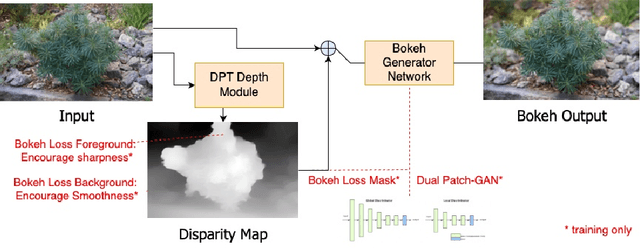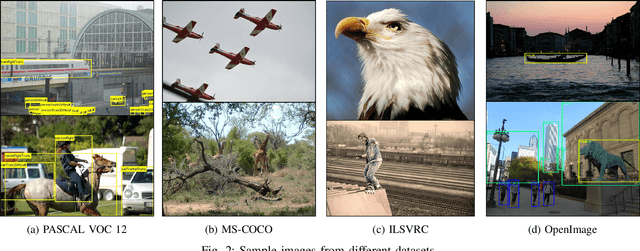Brian Lee
Single Trajectory Conformal Prediction
Jun 03, 2024Abstract:We study the performance of risk-controlling prediction sets (RCPS), an empirical risk minimization-based formulation of conformal prediction, with a single trajectory of temporally correlated data from an unknown stochastic dynamical system. First, we use the blocking technique to show that RCPS attains performance guarantees similar to those enjoyed in the iid setting whenever data is generated by asymptotically stationary and contractive dynamics. Next, we use the decoupling technique to characterize the graceful degradation in RCPS guarantees when the data generating process deviates from stationarity and contractivity. We conclude by discussing how these tools could be used toward a unified analysis of online and offline conformal prediction algorithms, which are currently treated with very different tools.
Realistic Bokeh Effect Rendering on Mobile GPUs, Mobile AI & AIM 2022 challenge: Report
Nov 07, 2022



Abstract:As mobile cameras with compact optics are unable to produce a strong bokeh effect, lots of interest is now devoted to deep learning-based solutions for this task. In this Mobile AI challenge, the target was to develop an efficient end-to-end AI-based bokeh effect rendering approach that can run on modern smartphone GPUs using TensorFlow Lite. The participants were provided with a large-scale EBB! bokeh dataset consisting of 5K shallow / wide depth-of-field image pairs captured using the Canon 7D DSLR camera. The runtime of the resulting models was evaluated on the Kirin 9000's Mali GPU that provides excellent acceleration results for the majority of common deep learning ops. A detailed description of all models developed in this challenge is provided in this paper.
Bokeh-Loss GAN: Multi-Stage Adversarial Training for Realistic Edge-Aware Bokeh
Aug 25, 2022



Abstract:In this paper, we tackle the problem of monocular bokeh synthesis, where we attempt to render a shallow depth of field image from a single all-in-focus image. Unlike in DSLR cameras, this effect can not be captured directly in mobile cameras due to the physical constraints of the mobile aperture. We thus propose a network-based approach that is capable of rendering realistic monocular bokeh from single image inputs. To do this, we introduce three new edge-aware Bokeh Losses based on a predicted monocular depth map, that sharpens the foreground edges while blurring the background. This model is then finetuned using an adversarial loss to generate a realistic Bokeh effect. Experimental results show that our approach is capable of generating a pleasing, natural Bokeh effect with sharp edges while handling complicated scenes.
A Survey of Modern Deep Learning based Object Detection Models
May 12, 2021



Abstract:Object Detection is the task of classification and localization of objects in an image or video. It has gained prominence in recent years due to its widespread applications. This article surveys recent developments in deep learning based object detectors. Concise overview of benchmark datasets and evaluation metrics used in detection is also provided along with some of the prominent backbone architectures used in recognition tasks. It also covers contemporary lightweight classification models used on edge devices. Lastly, we compare the performances of these architectures on multiple metrics.
Blockchain for Multi-Robot Collaboration to Combat COVID-19 and Future Pandemics
Oct 05, 2020
Abstract:This conceptual paper overviews how blockchain technology is involving the operation of multi-robot collaboration for combating COVID-19 and future pandemics. Robots are a promising technology for providing many tasks such as spraying, disinfection, cleaning, treating, detecting high body temperature/mask absence, and delivering goods and medical supplies experiencing an epidemic COVID-19. For combating COVID-19, many heterogeneous and homogenous robots are required to perform different tasks for supporting different purposes in the quarantine area. Controlling and decentralizing multi-robot play a vital role in combating COVID-19 by reducing human interaction, monitoring, delivering goods. Blockchain technology can manage multi-robot collaboration in a decentralized fashion, improve the interaction among them to exchange information, share representation, share goals, and trust. We highlight the challenges and provide the tactical solutions enabled by integrating blockchain and multi-robot collaboration to combat COVID-19 pandemic. The framework of our conceptual proposed can increase the intelligence, decentralization, and autonomous operations of connected multi-robot collaboration in the blockchain network. We overview blockchain potential benefits to defining a framework of multi-robot collaboration applications to combat COVID-19 epidemics such as monitoring and outdoor and hospital End to End (E2E) delivery systems. Furthermore, we discuss the challenges and opportunities of integrated blockchain, multi-robot collaboration, and the Internet of Things (IoT) for combating COVID-19 and future pandemics.
 Add to Chrome
Add to Chrome Add to Firefox
Add to Firefox Add to Edge
Add to Edge